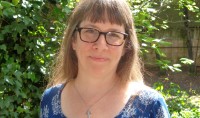As the world reopens post-pandemic, how will we find our way in it?
In Teresa of Avila, I’ve found a guide on this new path.

When classes moved online at the beginning of the pandemic, I swore to myself that when it was over, I would never use Zoom again. I hated the way the screen would freeze just as we were getting somewhere in class discussion, how people’s syllables would sometimes elongate into abstract, unintelligible sounds. I didn’t like speaking into the silence of politely muted microphones. I missed things I’d barely apprehended in the time before Zoom—the shuffling of papers, bodies shifting around, the sounds of people breathing. I missed the way a class could share a box of chocolates or a plate of cookies or pass around a book.
I still miss those things. But now I know that there are things that I will also miss about Zoom—not least walking over to my computer in the morning, tapping a few keys, and seeing the faces of my students appear. Some of my students are down the street, others across the world. No matter where we are, our faces are open to each other on the screen. I can see every grimace of disagreement, every smile of accord. I can almost see their questions forming before they ask them.
Read our latest issue or browse back issues.
At my university, we’ve been told to prepare for a full campus in the fall—wonderful news, hopeful news. But I’ve heard from a few students that they’re dreading a little the return to the intensity of busyness, the social pressures, the competing events. They, too, have found things to like in their online classes. They’ve had more face time (Zoom is nothing if not face time) with their professors, more control over their own participation. They’re nervous about what a return to “normal” will mean.
This is a small trepidation in the scheme of things. There’s so much to look forward to in a post-pandemic world: hugs, unmasked faces, gathering in churches and classrooms again. But our worries about how to reenter the world of classrooms and offices are reminders that the post-pandemic world also looms up as a challenge. As the world reopens, how will we find our way in it? We have an opportunity to do more than go back to the way things were—a chance, even a responsibility, to do better. How can we rise to it?
As I was thinking about what my own pathways back into the world might be, I picked up The Interior Castle, Teresa of Ávila’s exploration of the pathways of the human journey toward God. It might seem counterintuitive to read an account of an inward journey to think about a journey back out into the world, but Teresa seems always to be looking in both directions at once. The whole point of the journey inward, she writes, is to make ourselves fit for service to our neighbor; the whole point is to love more.
The first thing I noticed was her acknowledgment of how hard it is to get started on a new path, how weary it made her feel. I’m writing this book under obedience, she says on the first page, and I’m already finding it hard. God hasn’t given me any desire for this work, and my head is so full of noise that I can barely compose a letter about the most ordinary business, much less a book about prayer. Teresa is navigating issues of authority here, as a woman writer in the 16th century. But she also sounds like anyone who has ever tried to start a new creative project: unsure if she has it in her to do, fearful of all it will require.
The regathering and reopening that we are inching toward is a great creative project, especially if we see it not as a return to the way things were but as a chance to do things differently. It’s daunting, as Teresa knew, to push past our fear that we’re not up to the task. But she does. She writes her way past her misgivings and finds, in “the language used between women,” a way to say what she wants to say.
One of the temptations on the journey toward God, Teresa says, is the temptation to feel satisfied with where we are. Moving through the first three rooms of the interior castle, she says, we might begin to feel that we have found a stopping place. We pray, we meditate, we cultivate virtues. Why not be satisfied with that good life?
Teresa wants us to be dissatisfied. There’s so much more to explore on the path to God, she writes. We can love more; we can act with more justice and truth. We have the capacity for so much more transformation, so much more change.
The pandemic has made it impossible not to know what needs to be done; the injustices fracturing our world have been laid bare for all to see. As I heard a student ask in a presentation on the structural inequalities revealed by COVID: Will we still care when the pandemic is over? Will we stay dissatisfied enough to keep looking for new ways of living that cherish every life?
In the end, Teresa remained dissatisfied enough to write her book, to create new forms of community, to stay on the path to the interior castle until the life inside her and the life around her became one life. She reminds us to embrace dissatisfaction, to let it keep us on the path to the way things could be.
A version of this article appears in the print edition under the title “Reading Teresa as the world reopens.”






